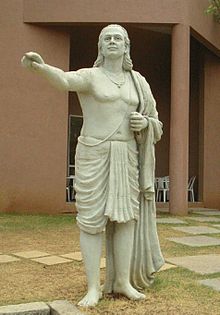Aryabhata
Aryabhata, आर्यभट (IAST: Āryabhaṭa) or Aryabhata I(476–550 CE) was the first of the major mathematician-astronomers from the classical age of Indian mathematics and Indian astronomy. His works include the Āryabhaṭīya (which mentions that in 3600 Kaliyuga, 499 CE, he was 23 years old)[6] and the Arya-siddhanta.
For his explicit mention of the relativity of motion, he also qualifies as a major early physicist.
Time and place of birth
Aryabhata mentions in the Aryabhatiya that he was 23 years old 3,600 years into the Kali Yuga, but this is not to mean that the text was composed at that time. This mentioned year corresponds to 499 CE, and implies that he was born in 476. Aryabhata called himself a native of Kusumapura or Pataliputra (present day Patna, Bihar).
Education
It is fairly certain that, at some point, he went to Kusumapura for advanced studies and lived there for some time. Both Hindu and Buddhist tradition, as well as Bhāskara I (CE 629), identify Kusumapura as Pāṭaliputra, modern Patna. A verse mentions that Aryabhata was the head of an institution (kulapa) at Kusumapura, and, because the university of Nalanda was in Pataliputra at the time and had an astronomical observatory, it is speculated that Aryabhata might have been the head of the Nalanda university as well. Aryabhata is also reputed to have set up an observatory at the Sun temple in Taregana, Bihar.
Mathematics
Place value system and zero
The place-value system, first seen in the 3rd-century Bakhshali Manuscript, was clearly in place in his work. While he did not use a symbol for zero, the French mathematician Georges Ifrah argues that knowledge of zero was implicit in Aryabhata's place-value system as a place holder for the powers of ten with null coefficients.
However, Aryabhata did not use the Brahmi numerals. Continuing the Sanskritic tradition from Vedic times, he used letters of the alphabet to denote numbers, expressing quantities, such as the table of sines in a mnemonic form.
Approximation of π
Aryabhata worked on the approximation for pi (π), and may have come to the conclusion that π is irrational. In the second part of the Aryabhatiyam (gaṇitapāda 10), he writes:
This implies that the ratio of the circumference to the diameter is ((4 + 100) × 8 + 62000)/20000 = 62832/20000 = 3.1416, which is accurate to five significant figures.
It is speculated that Aryabhata used the word āsanna (approaching), to mean that not only is this an approximation but that the value is incommensurable (or irrational). If this is correct, it is quite a sophisticated insight, because the irrationality of pi (π) was proved in Europe only in 1761 by Lambert.
After Aryabhatiya was translated into Arabic(c. 820 CE) this approximation was mentioned in Al-Khwarizmi's book on algebra.
Trigonometry
In Ganitapada 6, Aryabhata gives the area of a triangle as
- tribhujasya phalaśarīraṃ samadalakoṭī bhujārdhasaṃvargaḥ
that translates to: "for a triangle, the result of a perpendicular with the half-side is the area."
Aryabhata discussed the concept of sine in his work by the name of ardha-jya, which literally means "half-chord". For simplicity, people started calling it jya. When Arabic writers translated his works from Sanskrit into Arabic, they referred it as jiba. However, in Arabic writings, vowels are omitted, and it was abbreviated as jb. Later writers substituted it with jaib, meaning "pocket" or "fold (in a garment)". (In Arabic, jiba is a meaningless word.) Later in the 12th century, when Gherardo of Cremona translated these writings from Arabic into Latin, he replaced the Arabic jaib with its Latin counterpart, sinus, which means "cove" or "bay"; thence comes the English word sine.
Indeterminate equations
A problem of great interest to Indian mathematicians since ancient times has been to find integer solutions to Diophantine equations that have the form ax + by = c. (This problem was also studied in ancient Chinese mathematics, and its solution is usually referred to as the Chinese remainder theorem.) This is an example from Bhāskara's commentary on Aryabhatiya:
- Find the number which gives 5 as the remainder when divided by 8, 4 as the remainder when divided by 9, and 1 as the remainder when divided by 7
That is, find N = 8x+5 = 9y+4 = 7z+1. It turns out that the smallest value for N is 85. In general, diophantine equations, such as this, can be notoriously difficult. They were discussed extensively in ancient Vedic text Sulba Sutras, whose more ancient parts might date to 800 BCE. Aryabhata's method of solving such problems, elaborated by Bhaskara in 621 CE, is called the kuṭṭaka (कुट्टक) method. Kuṭṭaka means "pulverizing" or "breaking into small pieces", and the method involves a recursive algorithm for writing the original factors in smaller numbers. This algorithm became the standard method for solving first-order diophantine equations in Indian mathematics, and initially the whole subject of algebra was called kuṭṭaka-gaṇita or simply kuṭṭaka.
Algebra
In Aryabhatiya, Aryabhata provided elegant results for the summation of series of squares and cubes:[24]
and


No comments:
Post a Comment